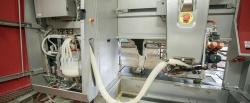Meadowbrook Adds Robotic Milking Facility
A new robotic milker at Eastern Kentucky University’s Meadowbrook Farm will give students hands-on access to the latest technology and significantly increase milk production.
The milker, purchased through a grant from the Kentucky Agricultural Development Fund, is a “fully automated system that is consistent in every sense of the word,” said EKU Farms Director Justin McKinney. “The milker does not require the dairy farmer to be present during each milking; therefore, the milking clusters are not manually connected as they are in a conventional parlor.”
The technology allows a lactating cow to voluntarily milk herself as needed, McKinney added, and the computer software program can collect valuable information on each individual animal.
EKU students will still learn how to run a dairy, McKinney noted, but “will be well versed on robotic milking procedures and can focus more on herd health and nutrition. Even though it is a fully-automated, self-contained system, students will learn how to identify individual cows based on data collected by the robot to treat sick animals, improve nutrition and better manage reproduction.”
It all translates to EKU students gaining “a competitive edge for employment,” McKinney said.
The milker is operated by a computer that recognizes each cow as it enters into the robot box by their RFID collar. With the transponder around the cow’s neck, the cow is identified and then serviced on an individualized basis. The computer recalls the cow’s architectural structure of the udder, using lasers to scan for each of the four teats on the cow. The computer program then charts the following per cow per day: body weight, pounds of milk, number of milkings, box time, milking speed (let down), refusals, failures, milk conductivity, and fat and protein content from all animals during each milking.
“Once the gate closes behind the cow, the computer recalls all of this information so it can care for the animal in a consistent, precise form, relaying the data to the farmer,” McKinney said. “The robot also is able to identify and divert milk from individual cows being treated with medications. This is all accomplished while the animal is happily eating a ration of pelleted food.”
An additional robot will replace the need to have a person push feed closer to the cows, and an automated cow brush and Grazeway gate improves animal well-being by giving the herd more opportunities to graze pastures and scratch their hides.
McKinney anticipates that milk production will decrease initially as the cows adjust to the new robotic parlor but increase “significantly” once they adapt. The production increase, he added, will come in two forms: an increase in milk frequency from twice a day to an average of 2.8 to 3.2 times per day, and an increase in milk production per cow per day because the farmer is able to devote more time to improving quality nutrition (improved crop management) and animal health “All of this is made possible due to the increase in labor flexibility and robot-collected data.”
Even though robotic milkers have been available commercially for more than 20 years, they have not been widely adopted until recent years. “The need to cut labor costs and specifically rising health insurance premiums is currently driving it,” McKinney said.
McKinney expects the robotic milkers to become the “new norm” for smaller private dairies in Kentucky. “A typical Kentucky dairy farm has a herd size of about 85 to 95 cows, which is close to the number a single robotic milker is able to milk within 24 hours. In my opinion, robotic milking will be the norm in less than 20 years for many states like Kentucky because a single robot can handle milking 50 to 70 cows in lactation at a time.
“If this trend continues, EKU students will be well prepared for any opportunity that presents itself in this field.”
For more information about the University’s Meadowbrook Farm, visit farms.eku.edu. For more information about programs offered through the EKU Department of Agriculture, visit agriculture.eku.edu.
Published on October 17, 2018
